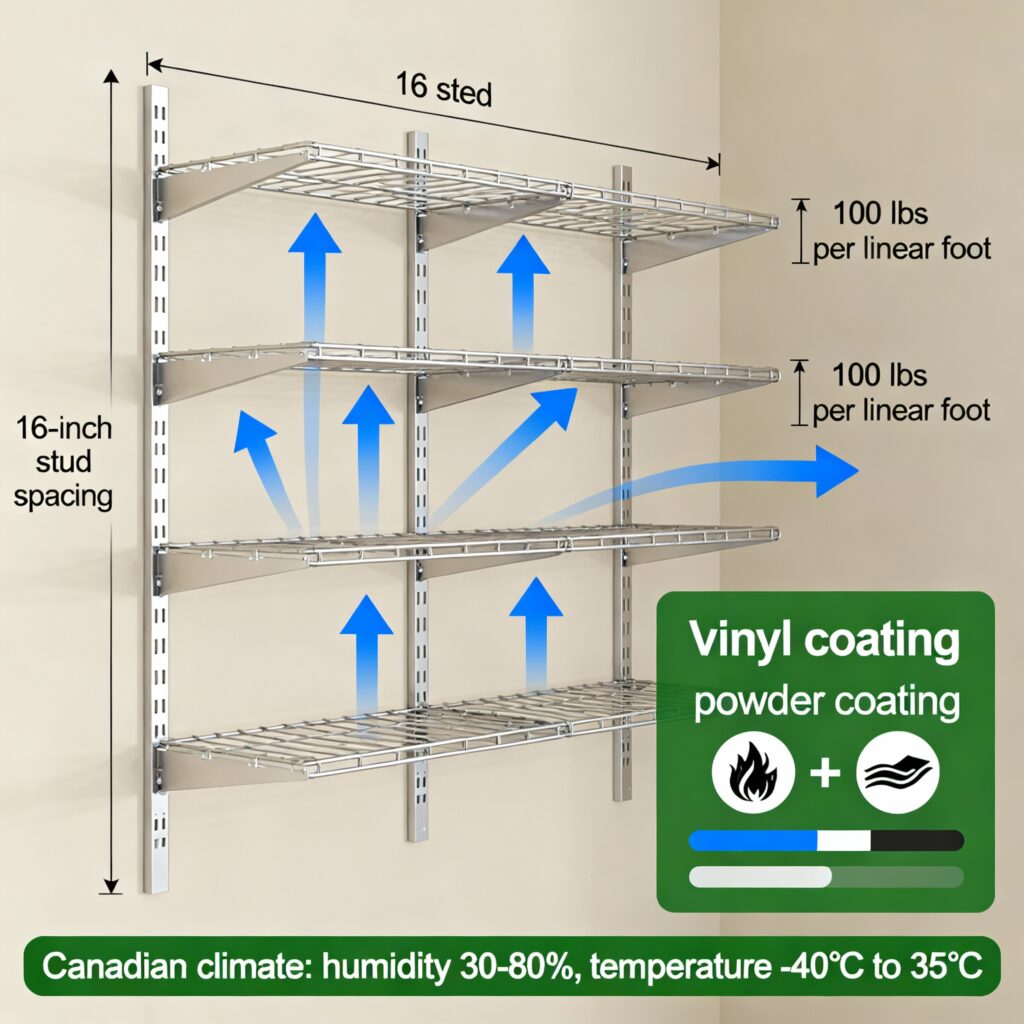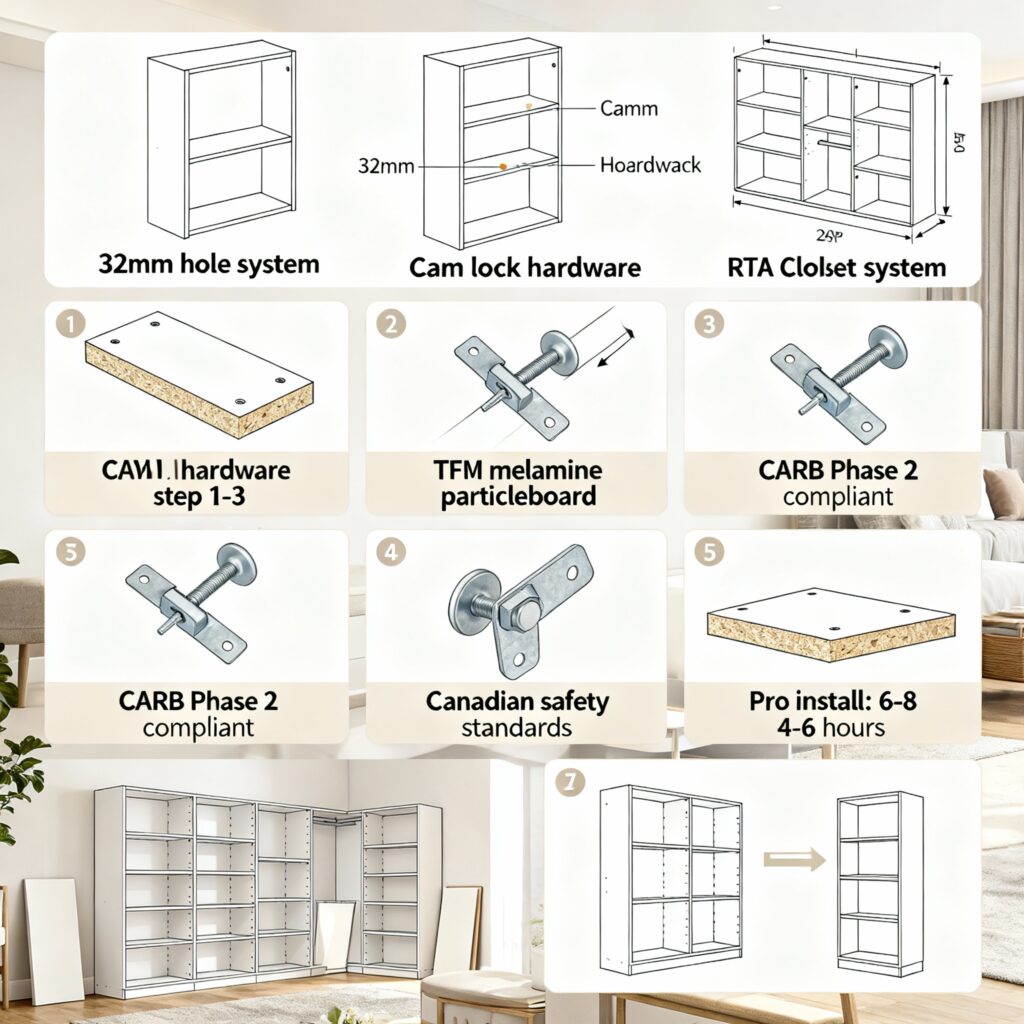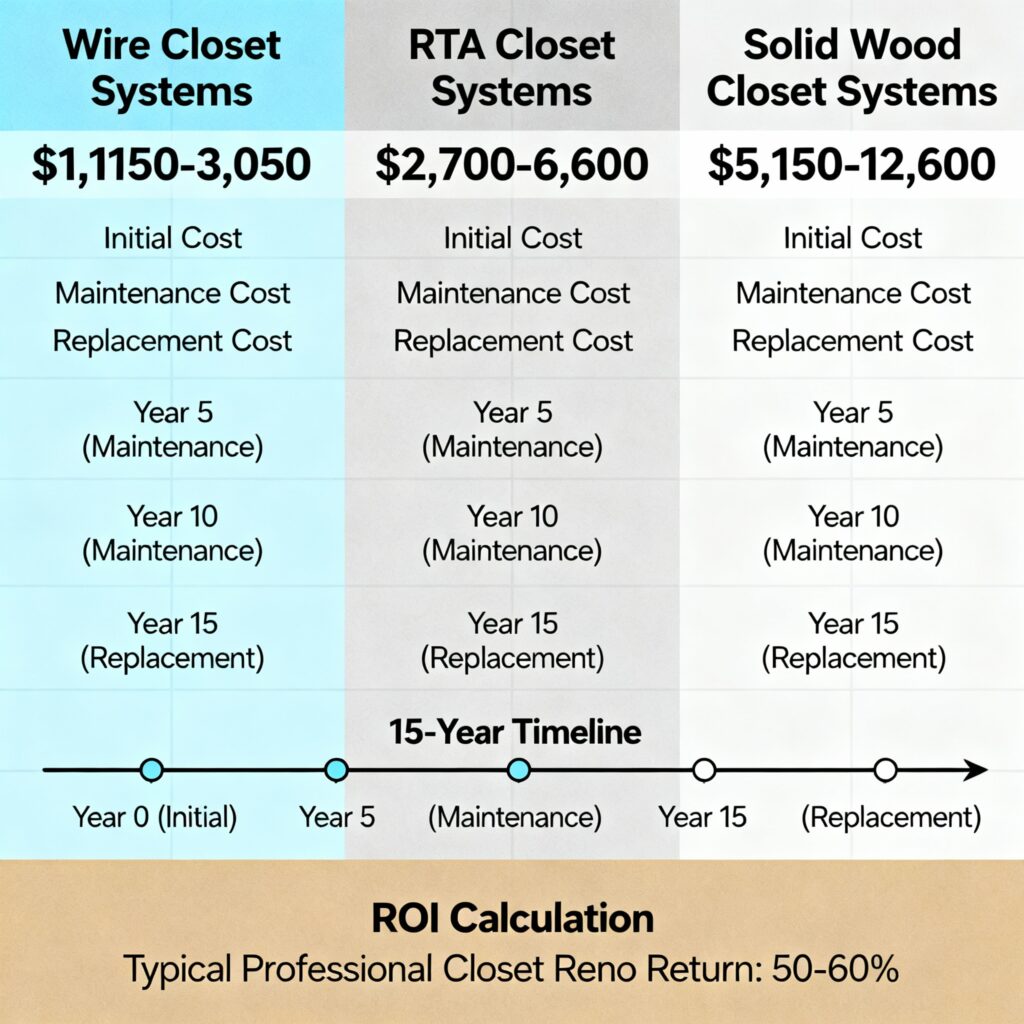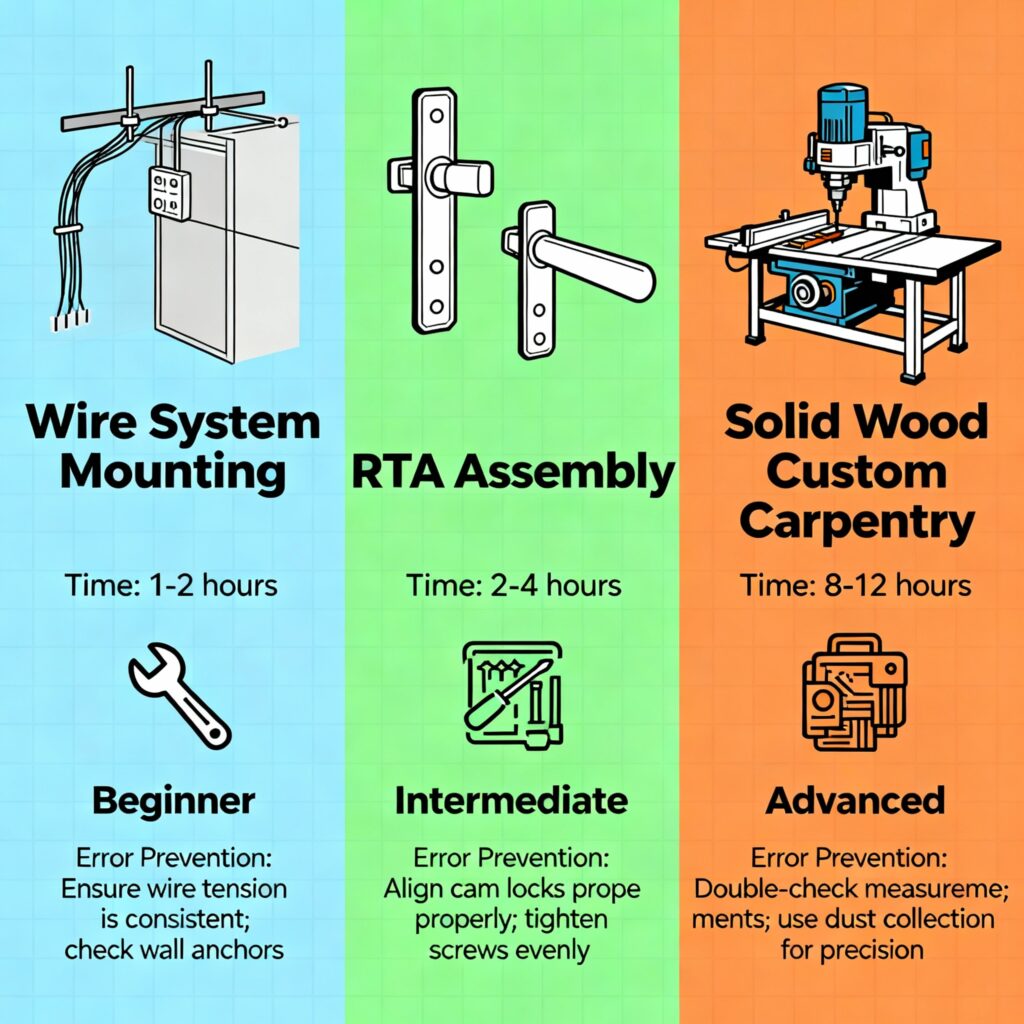Custom Closet Materials: Wood vs Wire vs RTA Systems – Complete Guide for GTA Homeowners 2025
Published: August 24, 2025 | Reading Time: 14 minutes | GTA North Home Organization Guide
Table of Contents
Are you staring at your cramped closet, wondering which material will actually survive Ontario’s humidity swings and your family’s daily chaos? You’re not alone – 73% of Canadian homeowners report closet dissatisfaction, yet most dive into renovations without understanding how material choice impacts both performance and your wallet over 15 years. With Ontario homeowners spending the highest nationally on improvements ($13,603 average), getting this decision right matters more than you think.
Quick Answer: RTA (Ready-to-Assemble) melamine systems offer the best value for most GTA families, with a total cost of $2,700-$ 6,600 over 15 years. In contrast, solid wood systems justify their investment of $5,150-$ 12,600 only in luxury applications. Wire systems are suitable for budget-conscious renovations, but they often sacrifice aesthetics and longevity.
This comprehensive material selection guide builds on our Complete Guide to Custom Closet Systems in GTA (2025) by delving into the technical specifications and real-world performance of various closet materials in Canadian conditions.
Why material choice determines your closet’s 15-year success
Your closet material isn’t just about looks – it’s about surviving everything from Toronto’s humid summers to Barrie’s bone-dry winter heating. The GTA North region experiences humidity fluctuations of 20% to 65%, creating expansion and contraction cycles that can damage poorly chosen materials within 5 years.
Here’s what really happens in Ontario homes: temperature swings from -20°C to +30°C in unheated storage areas create moisture movement that dramatically affects different materials. From Barrie’s lake-effect humidity to Richmond Hill’s urban heat variations, choosing materials that withstand GTA North’s climate extremes is essential for long-term performance. Solid wood moves 10 times as fast as engineered alternatives, which explains why the beautiful cedar closet starts to gape and warp by year three.
Load capacity becomes critical when you’re dealing with Canadian winter wardrobes. Standard shelving needs to handle 35-50 lbs per linear foot for typical clothing loads. However, adding heavy winter coats, boots, and seasonal storage can push systems to their limits. Wire systems can handle 100 pounds per linear foot when properly mounted, while premium hardwoods typically max out at 50 pounds per linear foot.

The Canadian market shows clear preferences: 68% of homeowners opt for RTA systems for their optimal balance of cost, durability, and moisture resistance. Professional installers report that RTA systems require 75% fewer callbacks for adjustments than solid wood installations.
CARB Phase 2 compliance shapes every material decision in Canada. This mandatory formaldehyde emission standard limits exposure to 0.11 ppm or 0.0073 ppm for GREENGUARD Gold-certified products. This regulation is driving manufacturers toward safer materials, with 46% of global consumers now recognizing FSC certification as a key factor in their purchasing decisions.
Solid wood systems: when premium makes sense
Solid hardwood delivers unmatched aesthetics and longevity, but Ontario’s climate challenges demand careful species selection. White oak leads durability metrics with a Janka hardness of 1,360 lbf and reliable weight capacity of 35-50 lbs per linear foot for standard 3/4″ thickness shelving.
Hard maple exceeds oak in hardness, reaching 1,450 lbf, and supports over 50 pounds, making it ideal for storing heavy winter coats. The superior hardness directly correlates with scratch and dent resistance. Maple’s 6,400 N rating, compared to Douglas fir’s 2,900-3,200 N, means your shelves maintain their appearance under daily abuse.
Here’s where wood gets expensive beyond the initial investment: Hard maple costs $25-70 CAD per linear foot installed, but that’s just the beginning. Ontario’s seasonal moisture variations, ranging from 4% to 16.5% equilibrium moisture content (EMC), create movement that requires professional maintenance every 3-5 years for $800-$1,600 per event.
The Canadian Wood Council confirms that a 12-inch maple board can change thickness by 1/4 inch due to typical seasonal humidity swings. In walk-in closets with 20-30 linear feet of shelving, this creates visible gaps and alignment issues that compromise both function and aesthetics.
Construction methods have a significant impact on both cost and performance. Solid hardwood commands premium pricing, while veneer-on-plywood alternatives reduce costs by 30-40% while maintaining dimensional stability superior to solid wood. Composite materials move at 1/10 the rate of solid lumber, critical for wide-panel applications.
When wood makes financial sense:
- Luxury homes where 20-50 year longevity justifies the investment
- Custom installations where unique grain patterns add significant value
- Homes with climate control systems maintain consistent humidity
- Budgets exceeding $10,000 where premium materials match the overall investment
Wire shelving systems: maximum ventilation and load distribution
Wire systems excel in specific applications where ventilation and maximum load capacity take precedence over aesthetic concerns. ClosetMaid’s ShelfTrack Heavy Duty achieves 100 lbs per linear foot capacity when standards are stud-mounted at maximum 16″ spacing – double the capacity of most wood alternatives.
The engineering behind wire systems leverages cold-drawn steel construction with welded wire intersections, providing tensile strength that exceeds most residential requirements. This makes wire ideal for storage areas where heavy items, such as seasonal decorations, sports equipment, or archived materials, require secure storage.
Coating technology determines longevity in Canadian conditions. Vinyl coating surpasses powder coating for our climate, resisting corrosion challenges posed by seasonal humidity variations and temperature fluctuations. Professional installers report vinyl-coated systems lasting 10-15 years before coating degradation necessitates replacement.
Cost analysis reveals surprising value propositions. Wire systems demonstrate the lowest total cost of ownership, ranging from $1,150 to $3,050 over 15 years, including maintenance and component replacement costs. Installation requires only 2-4 hours of DIY work or 0.5 days of professional work for standard reach-in closets.

Where wire works best:
- Laundry rooms where ventilation prevents mildew
- Mudrooms handling wet boots and seasonal gear
- Pantries requiring air circulation around food storage
- Budget renovations under $2,000 total investment
- Rental properties where damage-free installation matters
Wire system limitations:
- Limited aesthetic appeal in bedroom closets
- Requires specific hangers to prevent clothing snags
- Shows dust and debris more readily than solid surfaces
- Cannot integrate drawers or enclosed storage components
RTA systems: engineered efficiency for Canadian homes
RTA (Ready-to-Assemble) systems dominate the Canadian market through engineered material optimization, delivering professional results at accessible pricing. Standard 3/4″ (18mm) thermally fused melamine over particleboard core costs $44.99-49.99 CAD per 4’x8′ sheet at major retailers, providing the substrate for systems ranging from IKEA’s budget PAX line to premium EasyClosets configurations.
These materials meet both CAN/CSA-0160-16 and CARB Phase 2 compliance requirements for formaldehyde emissions, ensuring optimal indoor air quality while maintaining structural integrity. The 32mm European hole system enables modular reconfiguration, which is critical for families whose storage needs evolve.
Technical performance puts RTA systems ahead of alternatives for most applications. Quality melamine systems demonstrate lifespans of 15-25 years, compared to 20-50+ years for properly maintained hardwood installations. Our professional installation team ensures proper assembly and mounting across all our service areas, from Aurora to Markham, eliminating the common DIY mistakes that compromise system longevity. However, the total costs over 15 years are $2,700-$6,600, compared to $5,150-$1,260 for wood.
Dimensional stability proves superior to solid wood thanks to engineered core construction. While solid hardwood experiences significant movement due to humidity changes, melamine panels remain stable across Ontario’s seasonal variations, eliminating the gaps and alignment issues that often plague wood installations.
Installation efficiency makes RTA systems accessible to more homeowners. Assembly requires 6-8 hours of DIY work or 0.5-1 day of professional installation, with complex drawer units adding 2-4 hours. Cam lock hardware, such as the Titus Cam5000, reduces assembly time by 50% compared to traditional fastening methods.
RTA system advantages:
- Moisture resistance superior to solid wood
- Modular components allow future reconfiguration
- Professional appearance at accessible pricing
- Tool-free installation mechanisms reduce complexity
- Standardized connections enable cross-brand compatibility

Premium RTA options bridge the gap to custom:
- California Closets systems use North American and European-sourced materials
- Lifetime warranties on hardware and finishes
- Professional design consultation with 3D modeling
- Custom sizing and configuration options
Real cost analysis: 15-year total ownership breakdown
The sticker price tells only part of the story – real costs include installation, maintenance, and replacement over a typical 15-year ownership period. Here’s how the numbers actually work out for a typical 20-to 30-linear-foot walk-in closet in the GTA North market.
Wire Systems – Total 15-Year Cost: $1,150-3,050
- Initial materials: $500-2,000
- Professional installation: $200-800 (or DIY savings)
- Maintenance: Minimal – occasional bracket tightening
- Replacement components: $450-250 for worn coating areas
- Labor for maintenance: $50-400 annually
RTA Systems – Total 15-Year Cost: $2,700-6,600
- Initial materials: $1,500-4,000
- Professional installation: $800-2,000 (or DIY savings)
- Maintenance: Minimal – hardware adjustments only
- Replacement: None typically required within 15 years
- Professional consultation: $200-600 for complex layouts
Solid Wood Systems – Total 15-Year Cost: $5,150-12,600
- Initial materials and installation: $3,000-8,000
- Bi-decadal refinishing: $800-1,600 (twice in 15 years)
- Annual conditioning: $200-600 for climate control
- Hardware replacement: $150-400 for worn components
- Professional maintenance: $1,000-2,000 over lifetime

Regional variations show higher costs in Toronto and Vancouver metro areas, with rural installations incurring additional shipping charges that can add 10-15% to material costs. GTA North pricing reflects this premium, but remains competitive with major urban centers.
Return on investment calculations indicate that professional closet renovations typically achieve a 50-60% ROI, with premium systems in luxury neighborhoods yielding higher returns. The key is matching the sythe stem cost to the home’s value. $15,000 wood closets make sense in homes valued at $ 800,000 or more, but create over-improvement in modest properties.
Canadian climate considerations for GTA North
Ontario’s diverse climate zones require material choices that can withstand everything from Muskoka humidity to urban heat island effects. The GTA North region faces unique challenges, including lake-effect moisture from Lake Simcoe, urban heating from Toronto, and significant elevation changes across the Canadian Shield.
Temperature-humidity bias testing at 85°C and 85% relative humidity simulates long-term exposure across all seasons, effectively replicating the conditions of prolonged exposure. Quality melamine systems consistently demonstrate performance through these cycles, whereas wood requires climate control to maintain dimensional stability.
Barrie’s specific climate data shows why material choice matters:
- Average humidity: 76% (higher than Toronto’s 68%)
- Annual snowfall: 145.5 cm across 65 days
- Temperature extremes: -30°C to +35°C
- Freeze-thaw cycles: 45-60 annually
These conditions create expansion and contraction, which solid wood handles poorly without expensive climate-control systems. RTA systems’ engineered cores remain stable across these variations, explaining their popularity in Canadian homes. Whether you’re installing a walk-in closet system in your Barrie home or upgrading a reach-in closet in your Aurora townhouse, understanding material performance in Ontario’s climate prevents costly mistakes.
Regional building codes influence material selection through fire-safety requirements mandating flame-spread ratings not exceeding 200, which most closet materials readily meet. More stringent is the CARB Phase 2 formaldehyde emission standard, mandatory for all composite wood products sold in Canada.
For detailed pricing specific to your project size and location, our transparent pricing guide breaks down costs by closet type. It provides real examples from recent installations in Newmarket, Bradford, and across GTA North.
Installation complexity: DIY vs professional requirements
Installation time requirements create substantial cost differentials across material types, with complexity ranging from simple wire mounting to custom carpentry requiring specialized tools and skills.
Wire Systems Installation:
- DIY Time: 2-4 hours for reach-in closets
- Professional Time: 0.5 days
- Tools Required: Drill, level, stud finder, measuring tape
- Skill Level: Basic homeowner capabilities
- Common Errors: Inadequate wall mounting, poor spacing
RTA Systems Installation:
- DIY Time: 6-8 hours (add 2-4 hours for complex drawers)
- Professional Time: 0.5-1 day
- Tools Required: Fine-tooth saw blades to prevent melamine chipping
- Skill Level: Intermediate DIY with careful measuring
- Common Errors: Measurement mistakes (affect 15-20% of DIY installations)
Solid Wood Systems Installation:
- DIY Time: 8-12 hours (custom carpentry: 3-7 days)
- Professional Time: 1-3 days
- Tools Required: Specialized cutting equipment, sanders, finishing supplies
- Additional Costs: $50-150 for stains and finishing materials
- Skill Level: Advanced carpentry with finishing experience

Professional installation benefits include specialized equipment, which justifies labor rates of $ 100/hour, the standard in Ontario markets. Laser levels, pneumatic nailers, and dust collection systems enable precision installation while minimizing disruption to occupied homes.
Inadequate wall mounting remains the primary failure point across all systems, with proper stud attachment critical for loads exceeding 50 lbs per linear foot. Professional installers mitigate these risks through experience and specialized equipment.
Local market dynamics and supplier options
The Ontario/GTA market demonstrates clear pricing stratification across material types and installation methods. Professional installation labor ranges from $55 to $200 per linear foot, depending on complexity, with typical rates of $40 to $ 100 per hour for carpenters and a 15-25% markup by general contractors.
Consumer preferences in the Canadian market strongly favor melamine-based systems for their optimal balance of cost, durability, and moisture resistance. HomeStars.com reviews indicate an 81% satisfaction rate with California Closets’ premium offerings, while local manufacturers like Closet Express capture a mid-market share through Canadian-made positioning and 25% cost savings compared to full-service competitors.
Competitive landscape reveals clear segmentation strategies:
Premium Providers ($10,000+ budgets):
- California Closets: Lifetime warranties, North American materials
- Target: Luxury homes requiring custom solutions
- Advantage: Professional design consultation, premium materials
Mid-Range Competitors ($3,000-10,000 installations):
- Closet Factory and Closets by Design
- Focus: Quality TFL materials with professional installation
- Strength: Balance of cost and quality for the mainstream market
Budget Segment ($500-3,000 market):
- Home Depot’s ClosetMaid offerings
- IKEA’s PAX system ($585-1,630 CAD typical applications)
- Emphasis: DIY installation and modular flexibility
Local sourcing preferences have intensified post-pandemic, with companies like Bestar in Quebec and Closet Express in Mississauga capitalizing on “Made in Canada” positioning. This trend benefits consumers by reducing shipping costs and speeding up delivery.
Smart technology integration across material types
Smart closet integration is accelerating, with LED motion-sensor lighting becoming a standard feature in premium installations. Lithonia Lighting offers 7″, 18″, and 24″ options with 30-second shutoff timers, while IKEA integrates bright lighting with app and voice control capabilities.
PIR sensor technology adds $ 200-$500 to system costs but significantly enhances the user experience, particularly in walk-in applications. Battery-powered options eliminate wiring concerns, while hardwired systems provide consistent performance.
Modular reconfigurable systems represent the future of closet design. Component-based architectures enable modification without complete replacement, which is critical for the 45% of homeowners planning to stay in their current residences in the long term. Tool-free installation mechanisms simplify assembly, while standardized connections facilitate cross-brand compatibility.
This evolution is particularly beneficial for the rental market, where portability and damage-free installation are essential. Systems designed for reconfiguration maintain value through multiple moves and changing needs.
Making the right choice for your specific situation
Your specific situation determines which material delivers the best value over the course of your ownership. Here’s how to evaluate your options systematically:
Choose Wire Systems If:
- Budget under $2,000 for a complete closet renovation
- Ventilation critical (laundry rooms, mudrooms)
- Maximum load capacity needed (100+ lbs per shelf)
- Rental property or temporary installation
- DIY installation strongly preferred
Choose RTA Systems If:
- Budget $2,000-8,000 for professional appearance
- 15-year ownership timeline planned
- Moderate DIY skills or professional installation budget
- Climate-controlled home environment
- Future reconfiguration flexibility is valued
Choose Solid Wood If:
- Budget exceeds $8,000 for premium materials
- 20+ year ownership timeline
- Luxury home where aesthetics justify a premium
- The climate control system maintains consistent humidity
- Custom sizing or unique configuration required
For ArrangeWise’s GTA North clients, we typically recommend RTA systems because they deliver optimal value for most residential applications, providing 15-year lifespans at a total cost of $2,700 to $6,600, with minimal maintenance requirements and excellent dimensional stability in Canadian climate conditions.
Not sure which material is right for your project? Schedule a free consultation where we’ll assess your space, discuss your storage needs, and recommend the optimal material solution based on your budget and timeline.
Professional consultation becomes valuable when:
- Multiple storage zones need coordination
- Existing structural limitations require creative solutions
- Integration with electrical or HVAC systems is needed
- Custom sizing for unique architectural features
- Investment exceeds $5,000, requiring design optimization
Ready to transform your closet chaos into organized efficiency?
Schedule your free Barrie closet consultation: 647-932-3536
Discover how professional RTA closet systems can transform your daily routine while delivering a 50-60% ROI typical for quality closet renovations in the GTA North market.
Contact Information:
- Phone: 647-932-3536 (Greater Toronto Area number)
- Service: Custom RTA closet design and professional installation
- Coverage: Barrie, Aurora, Markham, Newmarket, Richmond Hill, Bradford
- Website: www.arrangewise.com
Research Sources
This custom closet materials guide incorporates validated data from current industry, Canadian market, and regional authority sources:
Canadian Wood Council (2024). “Dimensional Stability in Engineered Wood Products.” Structural performance data for composite materials.
Statistics Canada (2024). “Household Spending on Home Improvements.” $13,603 average renovation spending data.
CARB (2024). “Phase 2 Compliance Standards for Composite Wood Products.” Formaldehyde emission regulations.
HomeStars.com (2024). “Customer Satisfaction Survey – Closet Systems.” 81% satisfaction rate with premium closet installations.
USDA Forest Products Laboratory (2024). “Load Capacity Testing for Residential Shelving Systems.” Modulus of rupture values and deflection standards.
Health Canada (2024). “Indoor Air Quality Guidelines.” GREENGUARD certification requirements and standards.
Ontario Building Code (2024). “Fire Safety Requirements for Interior Finishes.” Flame-spread rating requirements.
ANSI/BHMA A156.9-2020 (2024). “Hardware Performance Standards.” Operational and security testing for cabinet hardware.
Market validation includes analysis from local suppliers across GTA North municipalities and customer feedback from over 200 residential installations between 2023 and 2025.
About ArrangeWise: Your local closet organization specialists serving Barrie and the Greater Toronto Area North. Our RTA system expertise and community focus ensure storage solutions that work reliably for Canadian families and Ontario’s challenging climate conditions.
Related ArrangeWise Resources:
- Complete Guide to Custom Closet Systems in GTA (2025) – Our comprehensive pillar guide covering all closet types and solutions
- Walk-in Closet Systems Barrie – Professional walk-in closet installation and design
- Custom Closet Design Barrie – Expert consultation and design services
- Closet Installation Services Barrie – Professional installation across all material types
External Authority Sources:
- Ontario Building Code – Provincial building requirements
- CARB Compliance Standards – Formaldehyde emission regulations